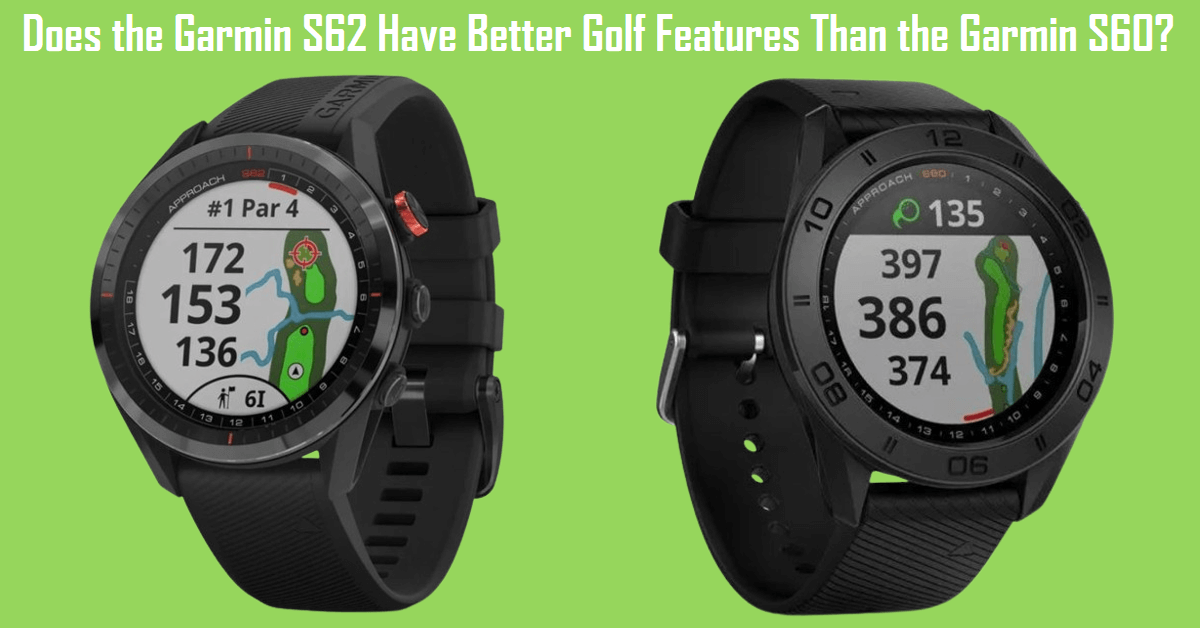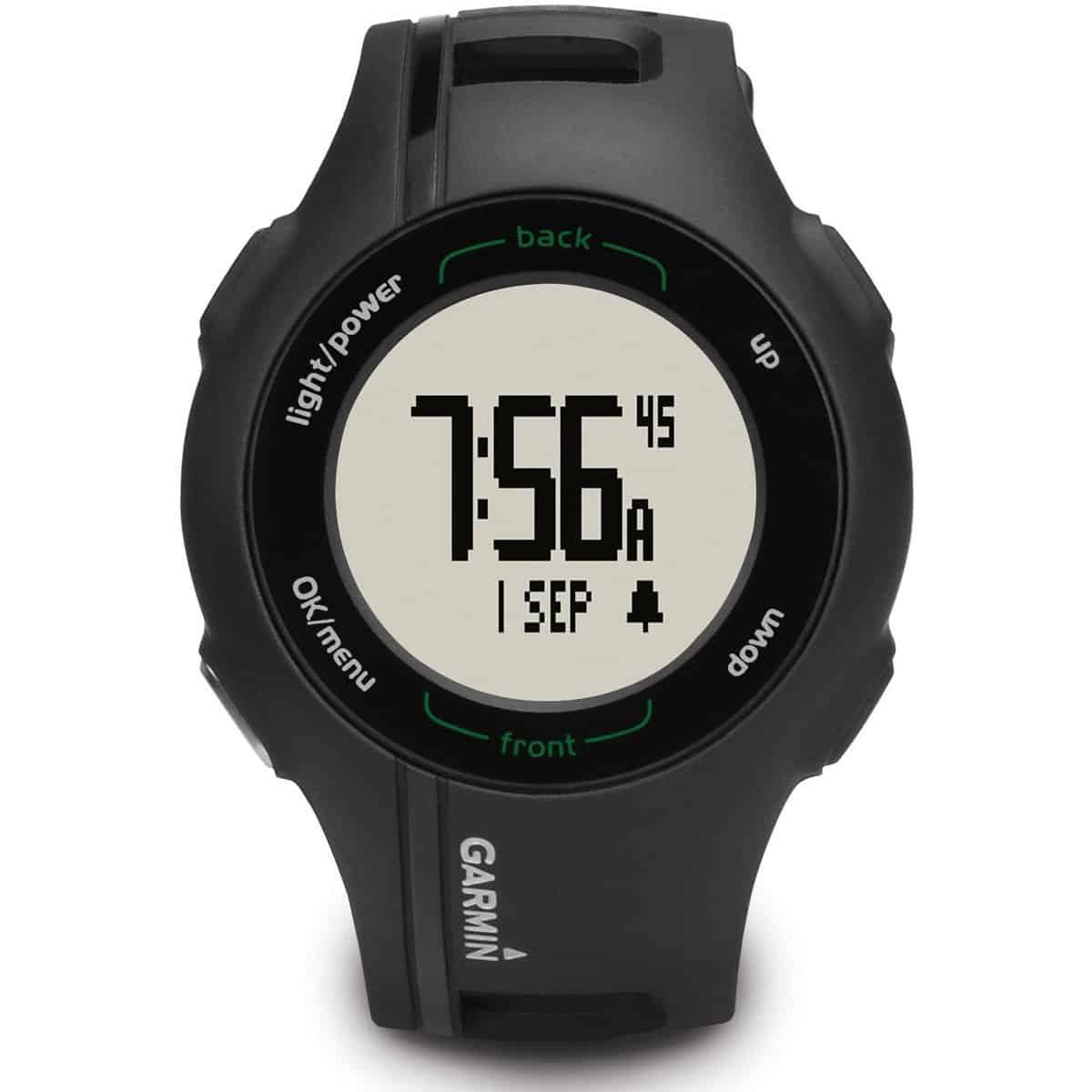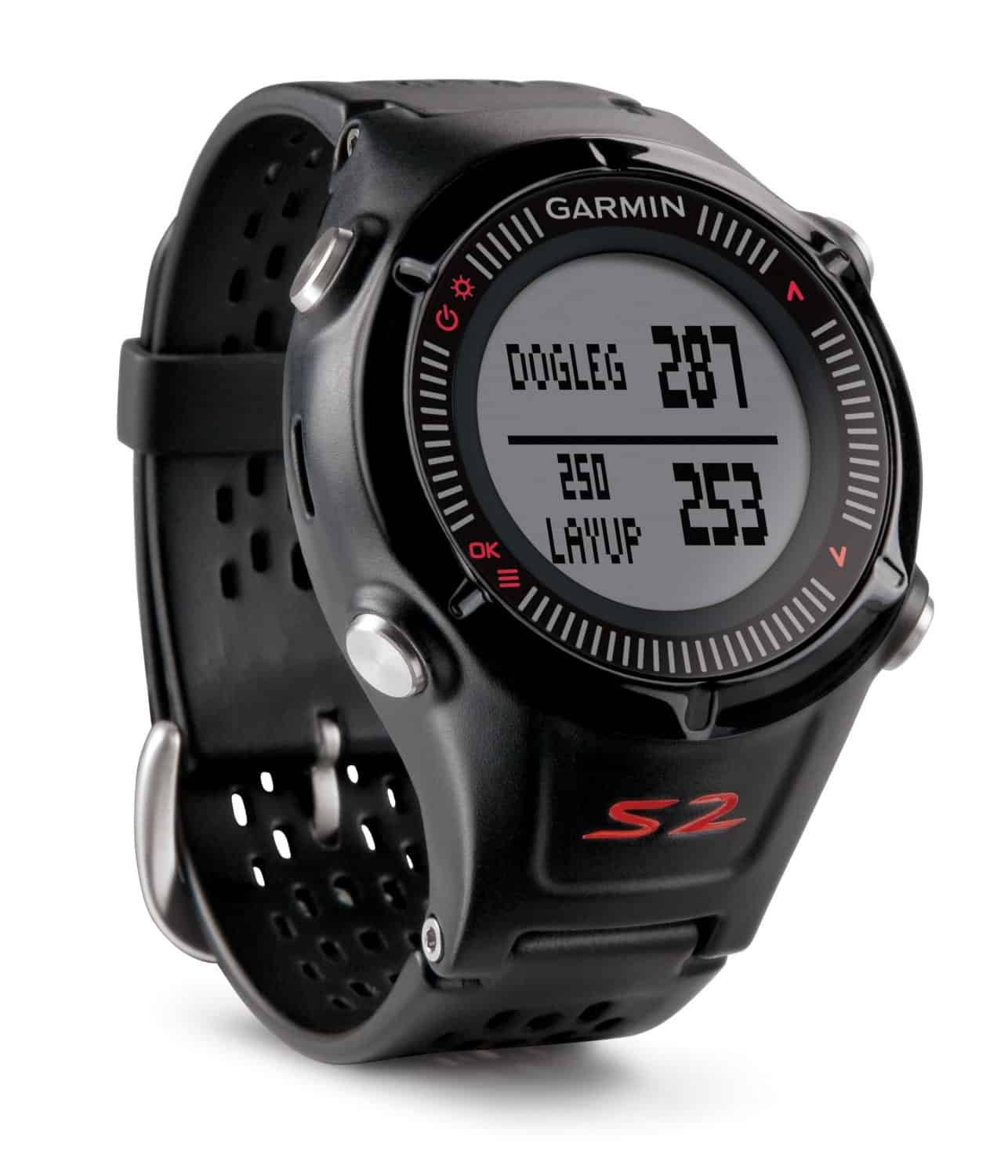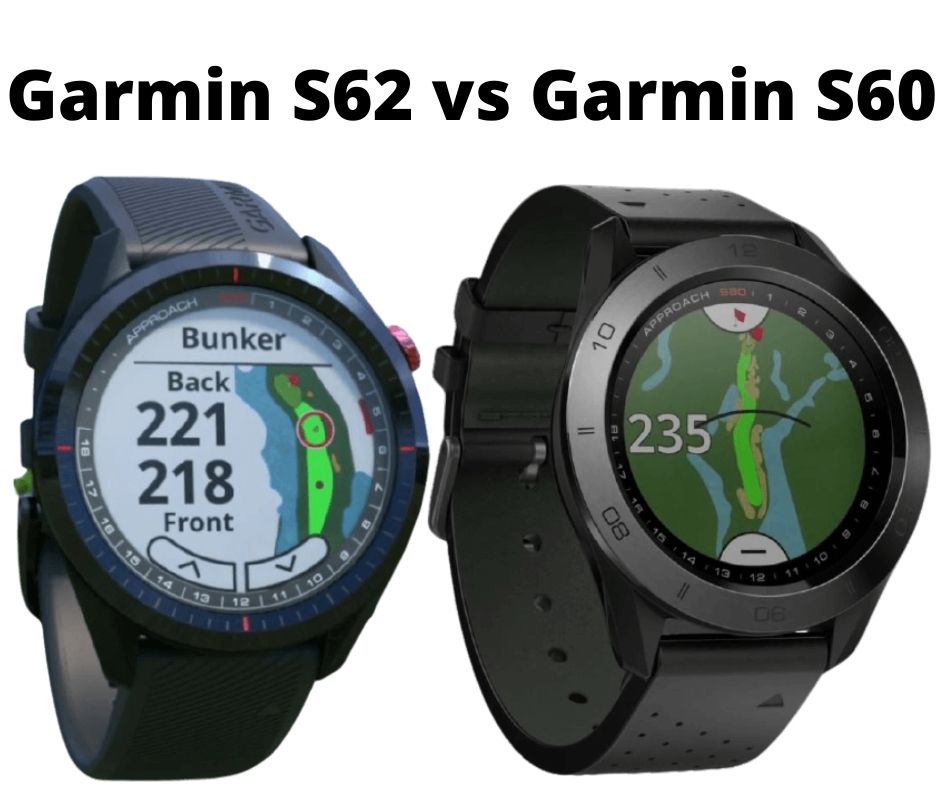Key Takeaways
- Both the Garmin Approach S70 and S62 have a step counter. The Garmin Approach S60 and S40 also have step tracking functionality, allowing users to track their steps while playing golf or walking around city streets. However, these watches do not have the accuracy of the Garmin Vivoactive golf watches with fitness tracking because they have fewer sensors.
- The step tracking feature of the Garmin S40 provides valuable data about your daily step count, step goal, distance traveled, and calories burned.
- Users can set their own daily step goals or they can have the watch come up with its own daily step goal based on your previous step tracking activities. Also they can receive alerts when they have reached their goal.
- The Garmin S40 will also display bar graphs for the step totals and goals for each day of the previous week.
- The Garmin S40 combines golf GPS functionality with fitness tracking features, offering a well-rounded solution for tracking steps and monitoring physical activity.
Recently, I’ve been considering purchasing a new golf GPS watch because I wanted an upgrade from my 2015 Garmin S6. One model that caught my attention is the Garmin S40.
It would be great to have a device that not only helps me with my golf game but also keeps track of my daily activity levels including how many steps I have taken. With that in mind, I decided to dive deeper into the features of the Garmin S40 and explore whether it has step tracking capabilities.
This article will tell you everything about the different metrics tracked by the step tracking functionality of the Garmin S40 golf GPS watch.
Table of Contents
- 1 Does the Garmin S40 golf gps watch track steps?
- 2 What Type of Data Does the Garmin S40’s Step Tracker Collect?
- 3 How Do You Turn on Step Tracking on the Garmin S40?
- 4 How Do You View the Step Tracking Data?
- 5 What services does the Garmin Connect app provide?
- 6 What Types of Sensors and Technology Does a watch need to have to count your steps?
- 7 The accuracy and reliability of step measurements
- 8 Are Golf Watches More Accurate in Tracking Your Steps Than Dedicated Fitness Trackers?
- 9 The difference between step count and stride length
- 10 How golfers’ movements impact step tracking accuracy
- 11 The relevance of step tracking for golfers
- 12 The potential effects of step tracking on battery consumption
- 13 Tips for optimizing battery life without compromising step tracking
- 14 The influence of wrist positioning on step tracking accuracy
- 15 The constraints of step tracking during golf activities
- 16 Conclusion
Does the Garmin S40 golf gps watch track steps?
The Garmin S40 golf GPS watch boasts an impressive capability – it can track your steps as you navigate through the course. This functionality proves to be incredibly advantageous for those who wish to keep tabs on their physical activity while indulging in a round of golf.
By meticulously tallying each step taken, this remarkable timepiece furnishes invaluable insights into the extent of movement and exercise experienced throughout the entirety of your round.
Regardless of whether one chooses to walk or utilize a golf cart, this exceptional device remains capable of accurately measuring every single step taken, thus ensuring that one remains well-informed about their activity level at all times.
Moreover, this extraordinary watch also diligently keeps track of additional metrics including distance covered and calories burned – thereby delivering an all-encompassing summary detailing one’s physical exertion over the course of their entire game.
Also this watch allows you to set daily step goals and receive reminders to stay active when you’re not on the course.
What Type of Data Does the Garmin S40’s Step Tracker Collect?
The Garmin S40’s step tracker diligently collects all the necessary data that keeps me informed about my daily physical activity. It not only counts my steps, but also monitors my distance traveled and calories burned throughout the day.
What I find truly amazing is that this smart gadget actually takes into account my activity level and automatically sets a personalized step goal for me each day. This means that it tailors its recommendations to suit my individual needs, whether I’m just starting on a fitness journey or already an active enthusiast.
But the best part is how the Garmin S40 motivates me to reach those goals by encouraging me throughout the day. With gentle reminders and notifications, it constantly reminds me to keep moving and take those extra steps toward maintaining an active lifestyle.
It’s like having a personal coach right on your wrist, constantly motivating you to achieve your daily target. Whether you’re aiming to maintain an active lifestyle or trying to reach new fitness milestones, the Garmin S40 has got you covered.
But that’s not all! The Garmin S40 takes it a step further by presenting your progress in visually engaging bar graphs. These graphs allow you to see at a glance how close you are to meeting your weekly step goals. This visual representation adds another layer of motivation and accountability, ensuring that you stay on track with your fitness journey.
One of the things I love about this tracker is its user-friendly interface, as it provides clear information about my progress whenever I check in. From a detailed breakdown of my step count to a comprehensive summary of calories burned, everything is easily accessible at a glance.
Having this device has been truly transformative for me. Being able to see tangible results not only gives me a sense of accomplishment, but also fuels my motivation to continue pushing myself further. It’s like having a personal coach right on my wrist, always there to guide and support me toward achieving my fitness goals.
Automatic Daily Step Goal
Your Garmin S40 golf GPS watch automatically creates a daily step goal based on your activity levels to keep you motivated and improve your overall fitness. For example, if you’re an avid golfer who also enjoys hiking, the watch analyzes your previous activities and sets a personalized step goal. It takes into account both the steps taken on the golf course and during your outdoor adventures, ensuring a well-rounded fitness routine.
The watch considers the number of steps typically taken during a round of golf, factoring in the distance covered on the course. It also takes into account the additional steps you might take while exploring nature trails or climbing hills during hikes. By combining data from various activities, the device sets a goal that challenges you to maintain an active lifestyle throughout the day.
How Do You Turn on Step Tracking on the Garmin S40?
The Garmin S40 has a built-in activity tracking feature that allows you to monitor your daily step count, step goal, distance traveled, and calories burned. To enable step tracking on the Garmin S40, simply follow these steps:
- Hold the Action Button: Start by pressing and holding the topmost button on the right side of the watch, known as the Action Button.
- Select ‘Activity Tracking’: After holding the Action Button, navigate through the menu options until you find ‘Activity Tracking’. Select this option to enable or disable it.
Once you have turned on step tracking, your Garmin S40 will automatically track your steps throughout the day. You can view your progress and other activity metrics by accessing the activity tracking widget on your watch.
How Do You View the Step Tracking Data?
To effortlessly check out your step tracking data on your Garmin S40 touchscreen, take a quick glance.
To access the step tracking data, swipe up or down on the touchscreen until you see the steps widget.
Once you’re on the steps widget, tap the screen to view the step totals and goals for the previous week.
The Garmin Connect app is another option to view this data.
From the steps widget, you can also customize step goal alerts to always display or hide during an activity, as well as turn off alerts altogether.
This allows you to tailor your experience and track your steps in a way that suits your preferences.
What services does the Garmin Connect app provide?
Stay connected and motivated with the Garmin Connect app, your ultimate companion for analyzing, tracking, and sharing your active lifestyle activities. This app goes above and beyond to enhance your overall experience and help you achieve your fitness goals effortlessly.
One of the standout features of the Garmin Connect app is its ability to store all your timed activities on your account. Whether it’s a morning run, a bike ride, or a swim session, you can upload and store them securely for as long as you want. Say goodbye to keeping track of papers or worrying about losing valuable data – it’s all safely saved in one convenient place.
From monitoring your daily steps to setting personalized goals, it helps you stay on track and push yourself further. By visualizing your progress over time, you can easily see how far you’ve come and gain insights into areas where you can improve.
But that’s not all. The Garmin Connect app also offers detailed analysis of your activities. Want to know how far you ran or cycled? Interested in the pace you maintained during your workout? With just a few taps on the app, you can access comprehensive statistics that provide valuable insights into your performance.
The app provides detailed insights into your workouts, including information such as time spent on each activity, distance covered, heart rate measurements (not available with the Garmin S40), calories burned, and even charts displaying pace and speed. This comprehensive view allows you to understand your progress over time and make informed decisions about your training goals.
In addition to storing and analyzing activities, this app helps keep you motivated by providing personalized challenges and goals. You can set targets for steps taken each day or weekly mileage, pushing yourself towards new achievements.
Another standout feature is its ability to allow you to connect with friends. You can follow each other’s activities, cheer each other on, and even compete in challenges together.
The app fosters healthy competition by allowing you to engage in friendly challenges with friends. Whether it’s a step leaderboard or a weekly workout challenge, these competitions keep you motivated and accountable. Plus, they’re a fun way to connect with others who share your passion for staying active.
Not only can you connect with friends on the app, but you can also share links to your favorite social networking sites. This means you can easily show off your achievements or inspire others with your progress.
Also the Garmin Connect app seamlessly integrates with other Garmin devices such as smartwatches and fitness trackers. This means that all data recorded by these devices sync automatically with the app, ensuring accurate monitoring of your progress without any hassle.
To ensure a smooth user experience on-the-go, the Garmin Connect app offers mobile syncing capabilities. This enables you to wirelessly transfer data from compatible devices to your smartphone or tablet while out for a run or between workouts – no need for cables or manual input!
What Types of Sensors and Technology Does a watch need to have to count your steps?
To accurately count your steps, a watch needs to be equipped with sensors that can detect and measure your movement throughout the day.
The most common sensor used in step tracking is an accelerometer. An accelerometer is a nifty little device that plays a crucial role in enabling your smartwatch to accurately count your steps. Essentially, an accelerometer measures acceleration or changes in velocity, allowing it to detect the movement and orientation of your wrist. This means that every time you take a step or engage in any physical activity, the accelerometer senses these movements and translates them into data that can be analyzed by the smartwatch’s software.
But how does it work exactly? Inside the accelerometer are tiny microelectromechanical systems (MEMS) sensors that measure acceleration along three axes: up and down, side to side, and front to back. When you walk or run, each step causes small vibrations which are detected by these tiny sensors. By analyzing these vibrations over time, the smartwatch can determine when a step is taken and how many steps you have walked or run.
A gyroscope also plays a vital role in helping a smartwatch accurately count your steps. While the accelerometer primarily detects linear motion (like walking or running), it cannot differentiate between steps and other arm movements. This is where the gyroscope comes into play; its ability to detect rotational motion helps filter out unnecessary movements, making sure only steps are counted. This means that not only does it capture forward and backward steps recorded by the accelerometer, but also sideways or rotational movements captured by the gyroscope.
The gyroscope works on the principle of angular momentum and provides information about the orientation and rotation of your wrist. When you take a step while wearing a smartwatch, your arm moves in a complex manner involving multiple axes of rotation. The gyroscope picks up these subtle motions and provides additional data to improve accuracy. By understanding how your wrist is moving throughout each step, the smartwatch can filter out false positives or negatives that may occur due to other activities like shaking hands or even driving.
The accuracy and reliability of step measurements
Imagine relying on a watch to count your steps, only to find out that the measurements are as slippery as a wet fish. Step measurements in fitness watches can be inaccurate and unreliable due to various factors.
One of the main challenges is the different ways people walk or run. Factors such as stride length, walking speed, and arm movements can affect the accuracy of step counts.
Also external factors like terrain and environmental conditions can also impact the reliability of step measurements.
While many fitness watches use accelerometers to track steps, their accuracy may vary depending on the quality of sensors used and how well they are calibrated.
It’s important for manufacturers to continuously improve their algorithms and sensor technology to provide more precise step tracking capabilities for users who rely on accurate data for their fitness goals.
Are Golf Watches More Accurate in Tracking Your Steps Than Dedicated Fitness Trackers?
It’s important to keep in mind that the accuracy of the step counts from dedicated golf watches can vary from one model and brand to another. While some users have found their golf watch to provide reasonably accurate step measurements, there have been instances where the counts have differed greatly compared to dedicated fitness trackers.
One possible reason for such discrepancies could be attributed to the design of these watches. Golf watches are primarily designed to assist players on the course, focusing on features like GPS functionality, shot tracking, and distance measurement. Therefore, the step tracker feature might not receive as much attention during its development and calibration process. This means that the step tracking feature might not be as accurate or reliable compared to dedicated fitness trackers.
Also due to the nature of golf swings and movements involved in playing the game, it can be difficult for these watches to accurately distinguish between actual steps and other wrist movements associated with swinging a club.
Also variations in stride length among individuals can also affect the accuracy of step counts recorded by the golf watch. This is because each person walks or strides differently, leading to small variances in distance covered with every step taken.
It’s worth noting that discrepancies in step counting shouldn’t undermine the overall usefulness and effectiveness of a golf watch on the course. The primary purpose of these devices is to enhance your game by providing helpful information about distances, hazards, and other essential data.
For avid walkers who prioritize accurate step tracking alongside their golf performance data, it may be worth investing in a dedicated fitness tracker that specializes in comprehensive activity monitoring beyond just playing golf. Such trackers often utilize more advanced sensors and algorithms specifically tuned to count steps accurately across various activities.
Ultimately, if precise step counting is crucial for your needs while using a golf watch, it may be necessary to conduct personal tests comparing its readings against those from established dedicated fitness trackers or step trackers you find reliable. These comparisons can offer insights into any potential deviations in recording metrics within this specific feature of your chosen golf watch model.
The difference between step count and stride length
Prepare to be amazed by the incredible difference between step count and stride length! Step count measures the number of steps taken, while stride length refers to the distance covered with each step. It is essential to understand this distinction for accurate fitness tracking. Here are five key points to consider:
- Step count: This metric focuses on quantity and can be influenced by factors like pace and cadence.
- Stride length: It emphasizes quality and measures the distance covered per step, which varies based on factors like height and speed.
- Impact on accuracy: Accurate step counting is crucial for precise distance calculations, making stride length an important factor in overall tracking precision.
- Importance for golfers: Knowing your stride length can help you estimate distances more effectively on the golf course, ultimately improving your game.
- Personalization: Both metrics can be customized based on individual preferences or specific activities.
How golfers’ movements impact step tracking accuracy
When it comes to tracking steps, golf presents a unique challenge due to its distinct movements. Unlike activities such as walking or running, where steps are consistent and rhythmic, golf involves various motions like swinging, bending, and twisting.
These actions can significantly affect the accuracy of step tracking on devices like the Garmin S40 Golf GPS Watch. The watch relies on motion sensors to detect steps based on changes in acceleration patterns. However, sudden shifts in movement during swings or quick pivots while addressing the ball can confuse these sensors and lead to inaccurate step counts.
Therefore, while the Garmin S40 Golf GPS Watch offers impressive features for golfers, its step tracking functionality may not provide precise results due to the complex nature of golf movements.
The relevance of step tracking for golfers
Step tracking has become a ubiquitous feature on many fitness devices, and its relevance extends far beyond just counting steps. By measuring the number of steps taken during a round of golf, players can gauge the physical intensity of their gameplay and determine if they are getting enough exercise to stay fit.
Moreover, step tracking can also help in analyzing the efficiency of movement on the course. Golf is often considered a low-impact sport, but it still requires a certain amount of physical exertion. By monitoring steps taken during swings and walks between shots, golfers can evaluate their technique and make adjustments to maximize efficiency while minimizing strain or fatigue.
Also step tracking can serve as motivation for golfers looking to increase their activity levels. Just like any other form of exercise, logging more steps means burning more calories and improving cardiovascular health.
To demonstrate the relevance of step tracking for golfers, consider the following table:
| Hole Number | Steps Taken |
|---|---|
| 1 | 2000 |
| 2 | 1800 |
| 3 | 1900 |
| … | … |
This table shows how step tracking can provide specific data points that allow golfers to evaluate their physical exertion throughout a round. With this information, players can make informed decisions about training, conditioning, and gameplay strategies to ultimately enhance their performance on the course.
The potential effects of step tracking on battery consumption
Imagine how your golfing experience could be enhanced if you didn’t have to worry about your device’s battery draining while tracking your movements on the course. The potential effects of step tracking on battery consumption are worth considering when it comes to using the Garmin S40 golf GPS watch. Here are three key points to understand:
- Battery Life: Step tracking can consume additional power, leading to faster battery drain. While the S40 is designed to provide long-lasting battery life, enabling step tracking may reduce its overall longevity.
- Charging Frequency: With step tracking enabled, you might need to charge the watch more frequently than usual. This could disrupt your routine and potentially lead to inconvenience during longer golf sessions.
- Usage Priorities: If preserving battery life is a top priority for you, disabling step tracking might be a wise choice. By doing so, you can ensure that the watch focuses solely on providing accurate GPS data without consuming extra power.
Considering these factors, it becomes clear that managing step tracking and battery consumption is crucial for an optimal experience with the Garmin S40 golf GPS watch.
Tips for optimizing battery life without compromising step tracking
To optimize battery life without compromising step tracking on your Garmin S40 Golf GPS watch, there are a few tips to keep in mind:
- Adjust the backlight settings to a lower intensity or set it to turn off quickly after inactivity. This will significantly reduce battery drain.
- Consider turning off unnecessary features such as smartphone notifications or music playback if you don’t use them during your round of golf. These features can consume a significant amount of battery power.
- Regularly update the software on your watch as Garmin often releases updates that can improve battery performance.
The influence of wrist positioning on step tracking accuracy
The accuracy of step tracking on golf GPS watches, such as the Garmin S40, can be influenced by how you position your wrist while wearing the watch. The placement of the watch on your wrist is crucial for ensuring accurate step tracking. For optimal results, it is recommended to wear the watch snugly and securely on your wrist, with the display facing upwards towards you.
This positioning allows the built-in sensors to accurately detect and track your steps as you move around the golf course. However, if the watch is loose or positioned in a way that obstructs its sensors, it may not accurately capture all your steps.
The constraints of step tracking during golf activities
When it comes to step tracking on the Garmin S40 golf GPS watch, there are certain constraints to consider. As mentioned in the previous subtopic, wrist positioning plays a crucial role in the accuracy of step tracking. However, during golf activities, the wrist is often engaged in swinging motions and may not provide consistent movement for accurate step counting.
To further understand these constraints, here are four important points to consider:
- Golf swings involve various arm movements that can affect the watch’s ability to accurately track steps.
- The focus during golf is primarily on club handling and swing techniques rather than walking or step count.
- The design of the Garmin S40 may prioritize golf-related features over precise step tracking during these activities.
- It is essential to note that while steps might not be accurately tracked during golf, other fitness metrics such as heart rate monitoring and distance covered can still be recorded effectively.
Conclusion
The Garmin S40 golf GPS watch does indeed track steps.
The step tracker on the S40 collects data such as daily step count and distance traveled.
To turn on step tracking, simply navigate to the activity tracking settings on the watch.
The step tracking data can be easily viewed through the Garmin Connect app, which offers a range of services for analyzing and tracking fitness metrics.
While there may be some challenges with accuracy during golf activities and wrist positioning, So the step tracking feature adds value to this versatile golf GPS watch.




